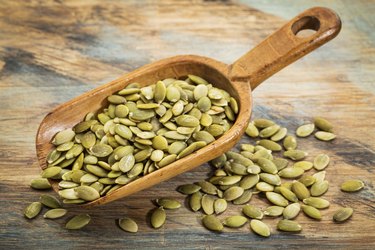
Ongoing controversy has surrounded vitamin B15, or pangamic acid, in determining the compound's structure and its classification as a vitamin. Although not readily available in the United States, vitamin B15 is marketed as an antioxidant that stimulates cellular respiration. However, little evidence has been determined regarding any beneficial biochemical or physiological function of vitamin B15 as a vitamin or a drug.
History
Video of the Day
Pangamic acid was isolated from apricots seeds in 1938 by Ernst Krebs and trade named B15 in 1943. It was described as having many detoxifying medical functions, including benefits to the skin, respiratory tract, nerves and joints. Vitamin B15 was used as a supplement in the U.S. until the 1970s, when it was banned from distribution. While many therapeutic uses of vitamin B15 are unproven, other countries continue to use vitamin B15, including Russia and some European countries, in the calcium pangamate form, appearing as dimethyl glycine, or DMG. In Russia, pangamic acid is used to increase athletic performance, reduce alcohol cravings and help reduce heart disease, senility and autism. In Europe, pangamic acid is used as an anti-aging agent and to protect against air pollution.
Video of the Day
Federal Approval
Commercially available pangamic acid products are not standardized and may contain indiscriminate amounts of gluconic acid, glycine, diisopropylamonium dichloroacetate and other materials. Because the chemical composition varies from product to product and insufficient evidence exists to show that vitamin B15 is effective for medicinal use, the U.S. Food and Drug Administration has not approved B15 and repeatedly seizes pangamic tablets. Vitamin B15 is also prohibited for distribution in Canada.
Function
Pangamic acid might serve as a methyl donor to help form certain amino acids. Vitamin B15 may play a role in glucose oxidation and cell respiration, says Elson M. Haas, M.D. and founder and director of the Preventative Medical Center of Marin. The claim is it may help hypoxia by increasing oxygen to the heart and other muscles. With vitamins C and E, vitamin B15 may act as an antioxidant, helping to protect cells from oxidation. Pangamic acid is also thought to stimulate the nervous system and promote liver function, which may contribute to detoxification.
Sources
Food sources of pangamic acid include beef blood, whole grains such as brown rice, brewer's yeast, pumpkin and sunflower seeds and apricot seeds. Dimethyl glycine is sometimes used as a substitute for vitamin B15 because it is thought to combine with gluconic acid to form pangamic acid in the body. As with any supplements, before taking pangamic acid consult your physician regarding medical conditions or drugs you are taking.
- “Arzneimittel Forschung”; Studies on the Chemical Identity and Biological Functions of Pangamic Acid; D. Schneider, et al.; April 1999
- "The American Journal of Clinical Nutrition"; Nutrition Education: Pangamic Acid; Victor Herbert, M.D., J.S.; July 1979
- "Nutrition Almanac"; Beneficial Effects on Ailments; Pangamic Acid; John D. Kirschmann; 2006
- U.S. Food and Drug Administration: CPG Sec. 457.100 Pangamic Acid and Pangamic Acid Products Unsafe for Food and Drug Use
- Healthy.net; Vitamin B15 – Pangamic Acid; Elson M Haas, M.D.